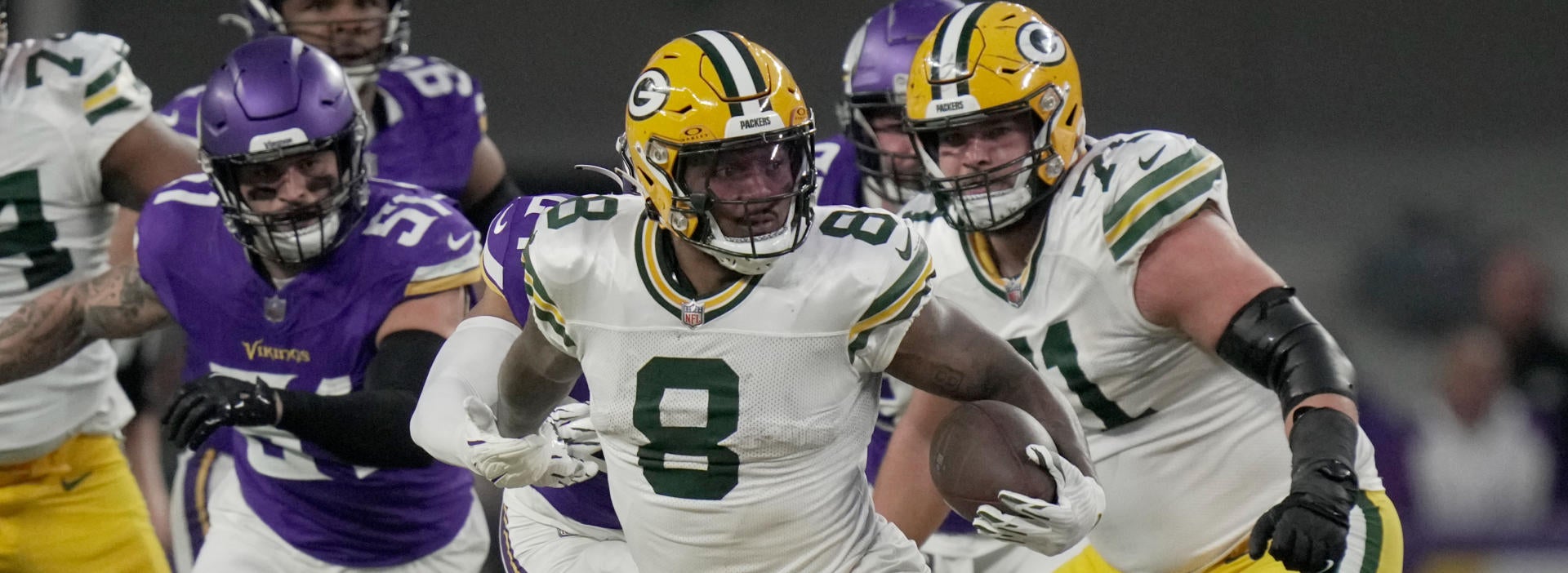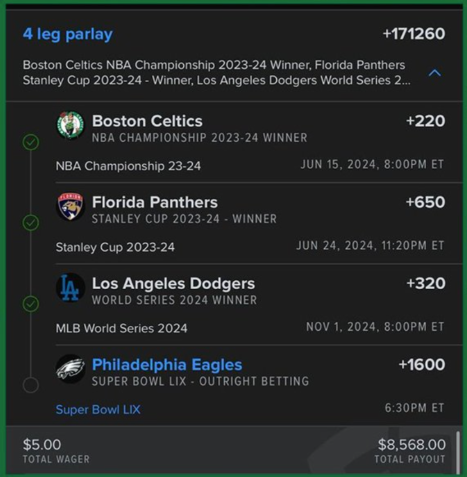Parlay betting guide: What a parlay bet is and how it works
From same-game parlays to round-robin parlays, these bets are exploding in popularity, but they're also widely known to offer odds that are not proportional to the expected value of a bet

Parlay betting is quickly becoming the most popular bet among recreational bettors. This bet is alluring because, in theory, it allows the bettor to wager a little and potentially win a lot.
However, parlay bets usually do not offer odds proportional to their expected value and bettors are more likely to lose in parlay betting than win because of this. Each added leg of a parlay compounds the house edge against a player, making the parlay less favorable for the bettor as opposed to betting each leg individually.
What is a parlay?
A parlay is a single bet that links together two or more individual wagers, which are also known as legs. For the parlay to win, all of the individual legs need to win.
For example, let's say a bettor has a budget of $150 to bet on an NFL Sunday, and he believes the following outcomes will occur.
- Packers to cover -2.5 (-110)
- Browns to cover +7.5 (-110)
- Dolphins to cover -3.5 (-110)
He could bet these games straight: $50 on the Packers, $50 on the Browns and $50 on the Dolphins. If all three teams cover, he would profit $45.45 on each of the bets.
The bettor could also combine these wagers into a three-leg parlay at nearly +600 odds. A $50 wager on a winning three-leg parlay at these odds would return nearly a $300 profit. Just remember, +600 odds have an implied win probability of about 14% vs. around 50% for -110 odds.
Just about any standard market can be included in a parlay. A bettor can link bets from multiple sports and leagues in a parlay, like an NFL point spread bet and an NBA money line bet. A bettor can also connect different player props in a parlay bet.
Some sportsbooks do allow correlated parlays, which are picks that make the other legs of the parlay more likely to occur. However, these picks are offered at reduced odds if available. For example, a bettor is unlikely to be able to parlay a soccer player to score a goal and have over 0.5 shots on target, as it is impossible to score without also having a shot on target.
The process of betting a parlay
Creating a parlay bet is the same as placing a straight bet, but with multiple legs. Let's say a bettor already has identified the four legs to include in a parlay. If the bettor is playing on a sportsbook app or website, they just need to select each of the four legs in the bet slip, and the sportsbook will generate the odds for that parlay. The bettor can then accept the parlay odds and place the wager or decline the odds and cancel the wager.
Here's an example of a winning four-leg parlay that was placed on FanDuel Sportsbook. In this case, the bettor correctly picked the 2024 champions in NBA betting (Celtics), NHL (Panthers), MLB betting (Dodgers) and NFL (Eagles) at parlay odds of +171260. The bettor turned a $5 wager into $8,568, showcasing the tremendous payout parlay betting provides when a bet wins. However, a win like this is incredibly rare and underscores some of the risks of parlay betting. If the Eagles didn't win Super Bowl LIX, the parlay bet would have lost even though the bettor successfully picked the other three legs.

Types of parlays
Parlay betting goes beyond the standard format of placing multiple individual wagers in the same bet slip. Some of the most popular types of parlays are same-game parlays, SGP+/SGPx, teaser parlays and round-robin parlays.
Same-game parlay
A same-game parlay, also known as a SGP, is exactly as it sounds: a parlay in which all of the legs are bets from a single game. Not every prop can be included in a same-game parlay, but spreads, totals, player props and game props are usually available.
SGP+/SGPx
These unique parlays combine a same-game parlay with a bet, parlay or same-game parlay from another game onto one ticket, creating essentially one giant parlay across multiple events.
Teaser parlay
Also known as a teaser, this is a parlay in which the bettor can adjust the point spread of a game. In return, the bettor must play two or more selections and will receive reduced odds.
Round-robin parlay
This parlay combines multiple parlays onto one ticket for the sake of efficiency. A bettor is making multiple wagers, but combining those on one bet slip to avoid placing each parlay separately. For example, let's say a bettor likes three NFL teams against the spread (Lions, Texans and 49ers), wants to tie these teams together in two- and three-team parlays and doesn't want to carry around multiple individual tickets. In this case, he can create a round-robin parlay, which would be four individual parlays.
- Lions and Texans
- Lions and 49ers
- Texans and 49ers
- Lions, Texans and 49ers
If any of the teams failed to cover, the bettor could still win one of the 2-team parlays using this method.
If a leg in a parlay pushes, that leg of the parlay is removed and the rest of the bet will remain. That would turn, for example, a four-leg parlay into a three-leg parlay. However, in a same-game parlay, some sportsbooks will void the entire parlay instead of removing a single leg.
Drawback of parlays
Parlays are considered unfavorable because people who bet parlays of three legs or more are compounding the house edge against them, sometimes to outrageous levels.
For example, let's say somebody likes Ohio State, Oklahoma and Texas A&M to cover the spread in college football betting. Let's assume each game is a virtual coin flip, with a 50% chance of going the bettor's way. The chances of all three games going the bettor's way are 0.5x0.5x0.5=0.125, or 12.5%.
The fair odds that should be associated with this are +700 (or 7-1). However -- and this is why parlays are not favorable for bettors -- a sportsbook will only pay +600 (6-1) on a three-team parlay. Getting +600 on any bet that should be +700 is a negative value.
However, if the bettor had bet Ohio State, Oklahoma and Texas A&M to cover straight up individually, they would have faced just a 4.6% house edge across each bet, and that is not compounded together.
Additionally, in this parlay, the bettor comes out ahead just 12.5% of the time. However, the bettor comes out ahead about 50% of the time when betting all three games individually.
Finally, the more legs that a bettor adds to a parlay, the more the bettor compounds that house edge against them. See the table below.
Number of Legs (priced at -110) | True Odds | Sportsbook Odds | House Edge |
4 | +1500 | +1200 | 18.75% |
5 | +3100 | +2400 | 21.88% |
6 | +6500 | +4700 | 25.00% |
"Once you start playing parlays with three teams or more, you don't get true odds," says Micah Roberts, a SportsLine expert who has worked in the Las Vegas sportsbook industry for 20-plus years, including a 13-year run as the sportsbook director for Station Casinos. "You're losing value each time you add a team."
With same-game parlays, the house edge can be even greater than regular parlays because the sportsbook will add an extra 10% to 20% of edge to make up for the possible correlation of legs. For example, let's say a bettor likes a quarterback to go Over or Under his passing total and a receiver on the same team to go Over or Under his receiving total and also score a touchdown. In that scenario, the true odds should be around +400 (or 4-1), but the sportsbook might only pay +300 (or 3-1). That's a 20% house edge.
Same-game parlays have some of the highest house edges of any bet type at the sportsbook.
Popularity of parlays
Despite the massive house edges, parlay betting has become incredibly popular. Over the first 10 months of 2024, parlay bets accounted for about 27% of the money wagered on all sports bets in Illinois, New Jersey and Colorado, states in which gambling regulators report data by bet type. That was up from 22% in 2021.
Sports betting companies contribute to the popularity of parlay betting by offering sportsbook promos for parlays, like profit boosts. They also post pictures of winning tickets on social media accounts, like the futures example above, which then go viral. These parlays, however, are the minority; losing parlay tickets do not receive the same social media treatment.
Parlay betting strategy
In parlay betting, there is one betting strategy to consider. According to Roberts, a bettor should stick to a two-team parlay at the most. A two-team parlay generally pays +260 (or 13-5 odds). Even though that is not equivalent to the true odds (+300 or 3-1), the house edge is not as large as it is for parlays of three, four or more teams.
"You're not going to win long-term betting parlays," Roberts says. "They're the entire reason these Las Vegas casinos have big, opulent sportsbooks."




